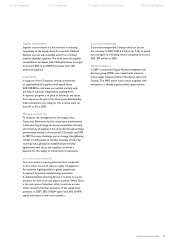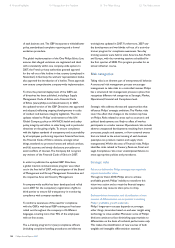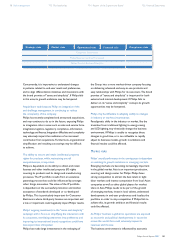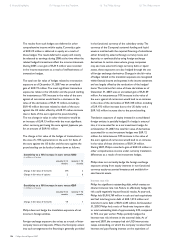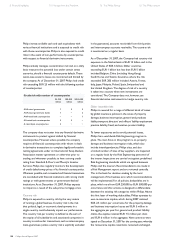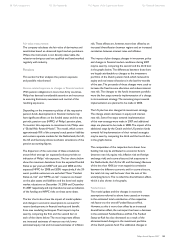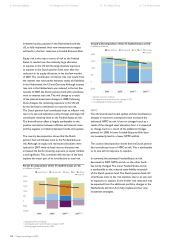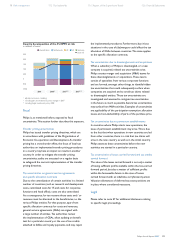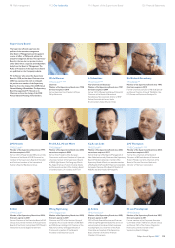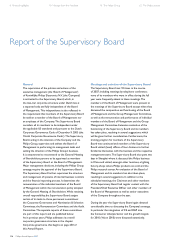Philips 2007 Annual Report Download - page 100
Download and view the complete annual report
Please find page 100 of the 2007 Philips annual report below. You can navigate through the pages in the report by either clicking on the pages listed below, or by using the keyword search tool below to find specific information within the annual report.
Philips Annual Report 2007106
The results from such hedges are deferred in other
comprehensive income within equity. Currently, a gain
of EUR 29 million is deferred in equity as a result of
these hedges. The result deferred in equity will mostly
be released to earnings during 2008 at the time when the
related hedged transactions affect the income statement.
During 2007, a net gain of EUR 4 million was recorded
in the income statement as a result of ineffectiveness of
transaction hedges.
The total net fair value of hedges related to transaction
exposure as of December 31, 2007 was an unrealized
gain of EUR 19 million. The most signicant transaction
exposures relate to the US dollar and the pound sterling.
An instantaneous 10% increase in the value of the euro
against all currencies would lead to a decrease in the
value of the derivatives of EUR 13 million, including a
EUR 45 million decrease related to deals of the euro
against the US dollar offset by a EUR 19 million increase
due to deals of the euro against the pound sterling.
The net change in value in other derivatives would be
an increase of EUR 13 million with the most signicant
other currency pair being the euro against Japanese yen
for an amount of EUR 10 million.
The change in fair value of the hedges of transactions in
the case of a 10% appreciation in the euro for deals of
the euro against the US dollar and the euro against
the
pound sterling can be further broken down as follows:
Sensitivity to a 10% increase in euro versus USD
in millions of euros
maturity 0-12
months
maturity > 12
months
Change in fair value of forwards (49)2
Change in fair value of options 2 0
Sensitivity to a 10% increase in euro versus GBP
in millions of euros
maturity 0-12
months
maturity > 12
months
Change in fair value of forwards 18 1
Philips does not hedge the translation exposure of net
income in foreign entities.
Foreign exchange exposure also arises as a result of inter-
company loans and deposits. Where the Company enters
into such arrangements the nancing is generally provided
in the functional currency of the subsidiary entity. The
currency of the Company’s external funding and liquid
assets is matched with the required nancing of subsidiaries
either directly by external foreign currency loans and
deposits, or synthetically by using foreign exchange
derivatives. In certain cases where group companies
may also have external foreign currency debt or liquid
assets, these exposures are also hedged through the use
of foreign exchange derivatives. Changes in the fair value
of hedges related to this translation exposure are recognized
within nancial income and expenses in the income statement
and are largely offset by the revaluation of the hedged
items. The total net fair value of these derivatives as of
December 31, 2007, was an unrealized gain of EUR 89
million. An instantaneous 10% increase in the value of
the euro against all currencies would lead to an increase
in the value of the derivatives of EUR 348 million, including
a EUR 192 million increase due to the US dollar and a
EUR 163 million increase due to the pound sterling.
Translation exposure of equity invested in consolidated
foreign entities is partially hedged. If a hedge is entered
into, it is accounted for as a net investment hedge. As
at December 31, 2007, the total fair value of derivatives
accounted for as net investment hedges was EUR 12
million. An instantaneous 10% increase in the value of
the euro against all currencies would lead to an increase
in the value of these derivatives of EUR 24 million.
During 2007, Philips recorded a gain of EUR 23 million in
other comprehensive income under currency translation
differences as a result of net investment hedges.
Philips does not currently hedge the foreign exchange
exposure arising from equity interests in non functional
currency equity-accounted investees and available-for-
sale nancial assets.
Interest rate risk
Philips has signicant outstanding debt, which creates an
inherent interest rate risk. Failure to effectively hedge this
risk could negatively impact nancial results. At year-end,
Philips held EUR 8,769 million in cash and cash equivalents
and had total long-term debt of EUR 1,212 million and
total short-term debt of EUR 2,345 million. At December
31, 2007, Philips had a ratio of xed-rate long-term debt
to total outstanding debt of approximately 34%, compared
to 74% one year earlier. Philips partially hedges the
interest-rate risk inherent in the external debt. As of
year-end 2007, the company had six USD interest rate
swaps outstanding, on which the company receives xed
interest and pays oating interest on the equivalent of
8 Financial highlights 10 Message from the President 16 The Philips Group 62 The Philips sectors



